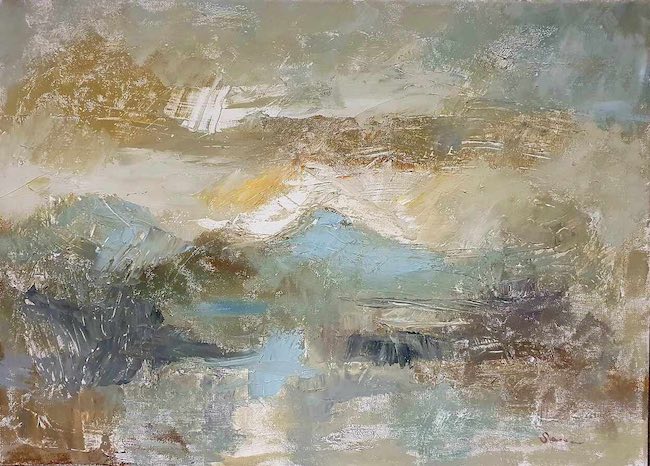Il filtro attraverso il quale ciascun creativo guarda e assorbe tutto ciò che appare davanti ai propri occhi, diventa di fatto la lente attraverso cui quelle realtà vengono poi concretizzate sulla tela, rivelando l’indole interiore e l’approccio verso il visibile del singolo esecutore di un’opera; laddove alcuni tendono a mostrare un’inclinazione fortemente realista, necessitante di soffermarsi sui dettagli per permettere loro di approfondire l’analisi su ciò che li circonda, altri invece avvertono il bisogno di rarefare le atmosfere, entrare nel mondo dell’indefinitezza e perdersi dentro la non forma per riuscire a interpretare quanto ricevuto nel momento dell’osservazione. E infine esistono artisti che scelgono di rimanere in una dimensione a metà strada tra il legame con l’ossevato, che però diviene trasposizione delle sensazioni percepite in un determinato frangente legato al vissuto, e la suggestione di spingersi verso l’astrazione per potersi connettere con la propria anima, con l’interiorità che ha memorizzato gli istanti contemplativi e che poi diviene canale di comunicazione espressiva. La protagonista di oggi mostra esattamente questo aspetto pittorico, un desiderio di restare sulla linea di demarcazione tra la realtà che può essere osservata e l’avvolgenza di un’emozione che invece sfuma i dettagli per cogliere l’essenza del sentire.
L’esigenza di inserire nell’opera d’arte tutto ciò che apparteneva all’interiorità dell’autore cominciò a emergere intorno agli inizi del Diciannovesimo secolo, quando cioè la nascita dell’Arte Romantica sottolineò la spinta dei nuovi protagonisti della pittura a infondere le loro tele di tutto quel mondo emozionale che in precedenza ne era stato escluso. Dal Romanticismo inglese rappresentato da William Turner, che mise in evidenza il sublime presente nei maestosi paesaggi che immortalava, e da John Constable il quale invece ebbe un atteggiamento più nostalgico e morbido nei confronti dei luoghi della campagna inglese dove era nato e cresciuto, passando per quello russo con Ivan Konstantinovič Ajvazovskij e quello norvegese con Johan Christian Dahl, ciò che fu chiaro in quel nuovo stile pittorico fu la necessità di avvolgere le opere con le sensazioni dell’autore, delle sue riflessioni sul rapporto tra precarietà della vita umana e maestosità della natura, dello stupore davanti alla bellezza dei paesaggi davanti ai loro occhi. Questi primi passi verso la consapevolezza dell’importanza del sentire e della soggettività dell’esecutore dell’opera gettarono le basi per tutti i successivi movimenti artistici a cavallo tra fine Ottocento e inizi Novecento che misero l’uomo, e pertanto l’artista, e le sue sensazioni al centro dell’espressione pittorica. Nel proseguire della ricerca verso questo tipo di concezione espressiva, persino l’Arte Informale, inizialmente dedita a distaccare completamente il gesto plastico da ogni tipo di contaminazione interiore da parte dell’autore, dovette fare i conti con la consapevolezza che senza emozione esecutiva, privando l’opera dell’enfasi interiore dell’artista, mancava il coinvolgimento dell’osservatore; fu così che intorno agli anni Cinquanta del Novecento nacque negli Stati Uniti l’Espressionismo Astratto, un movimento in cui la scelta della non forma diveniva un puro mezzo per entrare in comunicazione con tutto quel groviglio di sensazioni che premevano per fuoriuscire attraverso il gesto creativo. In particolar modo il Color Field di Mark Rothko si orientò verso una rappresentazione di paesaggi immateriali che appartenevano più all’anima che non a un luogo specifico. L’artista siriana Sawsan Diko, da molti anni residente in Austria, attinge alle esperienze pittoriche romantiche per infondere nell’osservatore il senso di maestosità della natura, dei paesaggi marini che costituiscono la maggior parte della sua produzione, e della bellezza, dell’amore e della pace che trasmettono i colori, ma poi la sua profonda sensibilità necessita di perdersi dentro l’indefinitezza dell’Espressionismo Astratto calmo e meditativo del Color Field per riuscire a esprimere tutta la suggestione, l’alchimia che i luoghi osservati hanno generato in lei e che hanno lasciato traccia nella sua memoria emotiva.
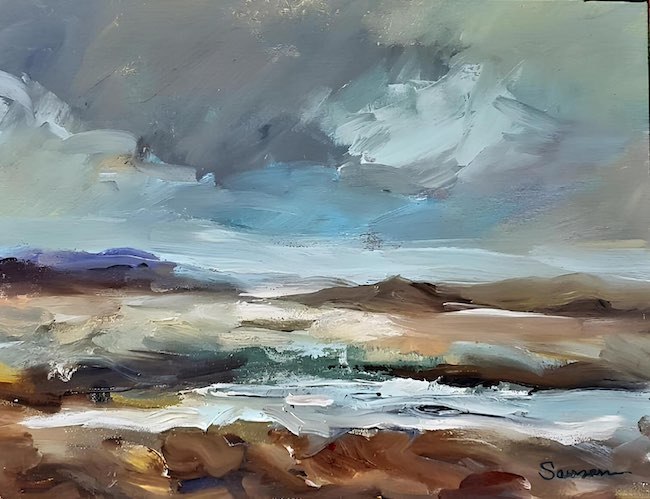
A colpire a un primo sguardo è la luce che domina ogni panorama descritto, come se tutto fosse costantemente avvolto dalla luminosità percettiva del ricordo, evocando una nostalgia che non volge mai verso la malinconia, piuttosto mostra un atteggiamento sognante da parte di Sawsan Diko, come se lo scrigno emotivo che apre ogni qualvolta si appresta a dipingere generasse in lei un trasporto e una serenità che non possono fare a meno di trasferisi sulla tela.

I suoi paesaggi sono prevalentemente invernali e autunnali perché in fondo è proprio in queste due stagioni che il mare può mostrare il suo lato più vero, senza il rumore dei villeggianti estivi e senza la maggiore calma primaverile, divenendo così catarsi di tutti i tumulti emozionali che appartengono all’interiorità dell’artista come anche di ciascun essere umano; la gamma cromatica è tenue, delicata, soffice, come se le atmosfere rarefatte anziché trasmettere il freddo della stagione a cui si riferiscono, avvolgessero invece l’osservatore conquistandolo in virtù della loro morbidezza.
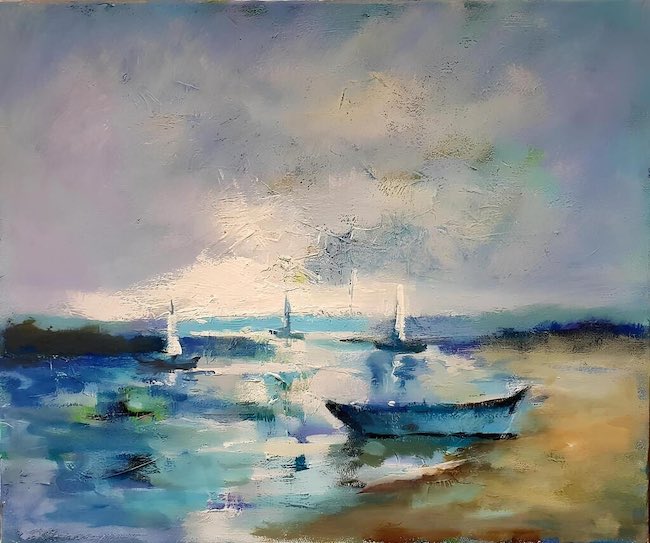
La metafora che fuoriesce dalle opere di Sawsan Diko è che spesso tutto ciò che è apparentemente freddo o gelido nasconde invece un nucleo più caldo e in grado di mostrarsi solo a chi riesce ad andare oltre il velo, la patina esterna che nasconde un’inaspettata ricchezza emozionale; tanto quanto ogni evento in cui sembra che tutto precipiti, in realtà possa in un secondo momento svelare aspetti positivi che non potevano emergere nell’immediato. È questo l’invito dell’artista verso l’osservatore, quello di non fermarsi all’immagine che sembra esservi a una prima occhiata, bensì avvicinarsi entrando nel mondo delicato del colore e delle sfumature con cui struttura le sue tele, stratificando l’acrilico per poi agire su di esso con il grattage che rende persino più incisivo il concetto di andare oltre l’esteriorità per trovare la dimensione dell’anima.
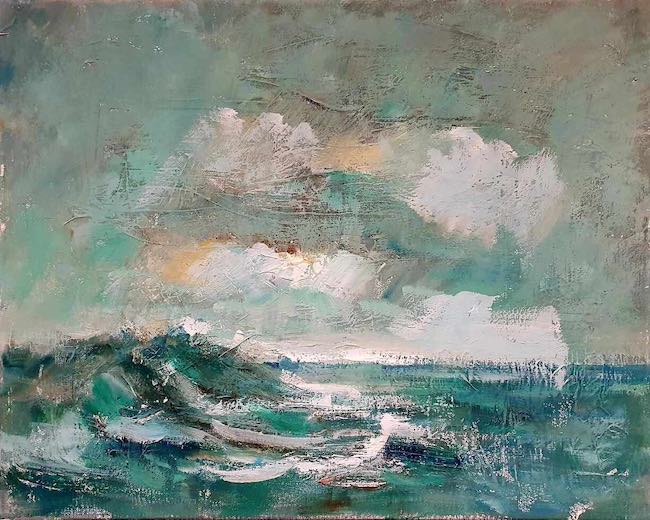
In Beautiful Memories emerge in maniera evidente la stretta connessione con il mondo interiore perché il paesaggio narrato appartiene a un luogo non luogo che trova la sua struttura più consistente nei ricordi di Sawsan Diko, quell’inganno visivo che la induce a decontestualizzare le tonalità fino a farle divenire affini all’intensità del suo sentire; ciò che conta infatti non è l’aspetto esatto e l’individuazione del luogo in cui si trova il mare protagonista della tela, piuttosto è importante l’atmosfera generale, l’impatto emotivo che ha fatto vibrare le sue corde nel momento della contemplazione. L’indefinitezza dei dettagli è funzionale ad abbandonare la razionalità e lasciarsi andare al puro sentire, alla pura emozione.
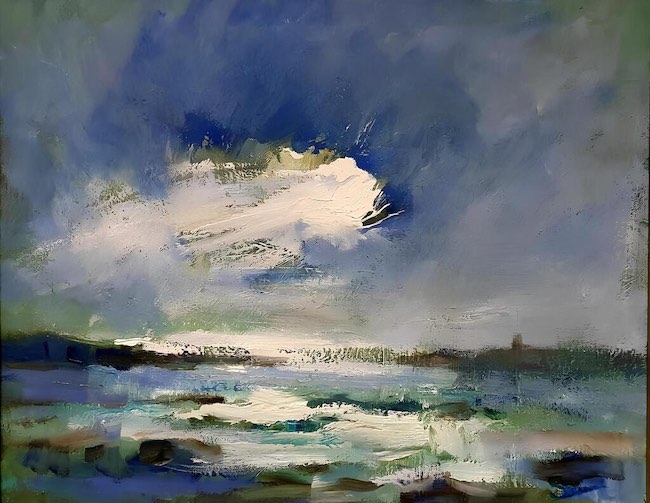
Allo stesso modo anche Winter near the cost presenta la medesima tendenza espressiva, la mancanza di chiarezza visiva serve a indurre il fruitore a perdersi semplicemente dentro le tonalità intense e fredde dell’inverno, rappresentate dall’azzurro e dal bianco, ma al contempo non riesce a non percepire il medesimo trasporto incantato vissuto da Sawsan Diko, come se in quella gamma cromatica e nel grattage vi fosse qualcosa di più di una semplice osservazione, come se fuoriuscisse un senso di appartenenza, un richiamo verso la bellezza incontaminata di quel mare che può armonizzarsi con i sussulti interiori e assorbirne la parte più turbolenta portandola via con sé tra le onde. In qualche modo dunque il mare diviene una purificazione dalle ansie e dai timori e trasmette quel senso di infinito in grado di ridimensionare un’oggettività troppo spesso ingigantita proprio dall’incapacità di avere un punto di vista più equilibrato.
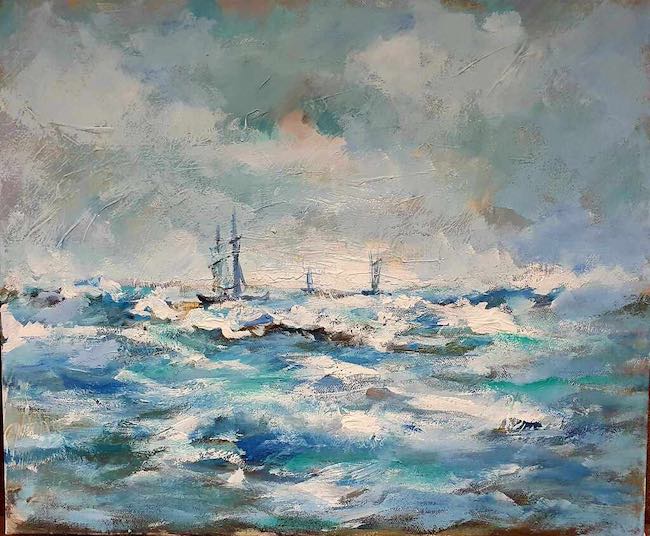
In Venice coast invece, l’artista si lascia cullare dal ricordo di un periodo trascorso nella città lagunare, ne racconta le acque più che il suo aspetto perché è sempre nell’acqua che Sawsan Diko trova la sua dimensione ideale, quella in cui riesce a esprimere il lato più profondo di sé, quello che non ha bisogno di null’altro che del silenzio e dell’approccio evocativo in virtù del quale la sua interiorità è in grado di affiorare, divenire consapevole e solo poi apprezzare anche la parte più razionale e visiva di ciò che è intorno a sé. Il mare al largo di Venezia in questa tela è agitato, forse allo stesso modo in cui lei si è emozionata nel momento in cui si è trovata faccia a faccia con l’eternità della bellezza di quel luogo incantato e al tempo stesso sospeso in una dimensione ovattata, suggestiva e struggente, dunque ancora una volta l’acqua si fa interprete delle sensazioni che si muovono all’interno di sé in particolare e dell’essere umano in generale.
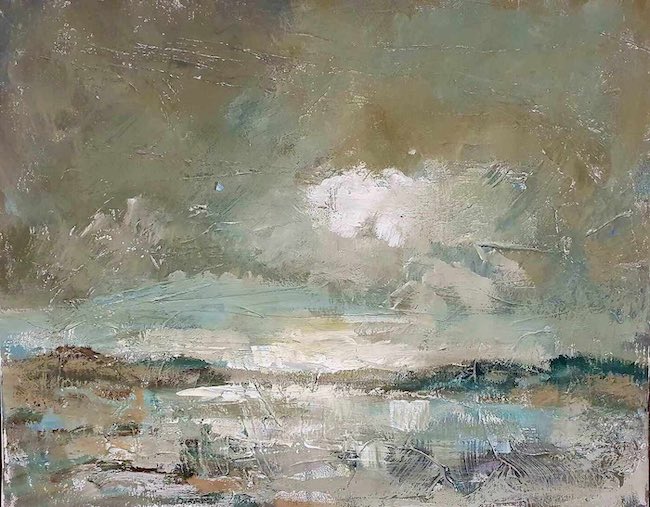
Sawsan Diko, designer e artista, è diventata pittrice grazie all’incoraggiamento del suo maestro siriano, l’artista plastico Muhammad Naji Obaid che le ha insegnato ad amare e mescolare sapientemente i colori, vive a Vienna dal 2015 e ha al suo attivo mostre personali a Damasco e a Dubai, ha partecipato a esibizioni collettive in Siria, negli Emirati Arabi Uniti, in Austria, in Italia e in Romania ricevendo consensi da parte del pubblico e della critica e molte riviste e canali televisivi internazionali hanno parlato della sua arte.
SAWSAN DIKO-CONTATTI
Email: sawsandeko@gmail.com
Facebook: www.facebook.com/sawsan.dikou
Instagram: www.instagram.com/sawsan_diko_/
The emotional evocation of the observed in Sawsan Diko’s landscapes suspended between Romanticism and Abstract Expressionism
The filter through which each creative looks at and absorbs everything that appears before their eyes, becomes in fact the lens through which those realities are then concretised on canvas, revealing the inner nature and approach towards the visible of the individual executor of an artwork; Where some tend to show a strongly realist inclination, needing to dwell on details to enable them to deepen their analysis of their surroundings, others instead feel the need to rarefy atmospheres, enter the world of indefiniteness and lose themselves within non-form in order to be able to interpret what they receive at the moment of observation. And lastly, there are artists who choose to remain in a dimension halfway between the link with the observed, which, however, becomes a transposition of the sensations perceived at a given juncture linked to experience, and the suggestion of pushing towards abstraction in order to connect with their own soul, with the interiority that has memorised the contemplative moments and which then becomes a channel of expressive communication. Today’s protagonist shows exactly this pictorial aspect, a desire to remain on the demarcation line between the reality that can be observed and the envelopment of an emotion that instead blurs the details to capture the essence of feeling.
The need to include in the work of art everything that belonged to the interiority of the author began to emerge around the beginning of the 19th century, when the birth of Romantic Art underlined the drive of the new protagonists of painting to infuse their canvases with all that emotional world that had previously been excluded. From English Romanticism represented by William Turner, who emphasised the sublime in the majestic landscapes he immortalised, and by John Constable who instead had a more nostalgic and softer attitude towards the places in the English countryside where he had been born and raised, passing through the Russian one with Ivan Konstantinovich Ajvazovsky and the Norwegian one with Johan Christian Dahl, what was clear in that new style of painting was the need to envelop the artworks with the author’s feelings, his reflections on the relationship between the precariousness of human life and the majesty of nature, his astonishment at the beauty of the landscapes before his eyes. These first steps towards an awareness of the importance of the feeling and subjectivity of the work’s creator laid the foundation for all subsequent artistic movements at the turn of the 19th and early 20th century which placed man, and therefore the artist, and his feelings at the centre of pictorial expression. As research towards this type of expressive conception continued, even Informal Art, initially dedicated to completely detaching the plastic gesture from any kind of inner contamination on the part of the author, had to come to terms with the realisation that without executive emotion, by depriving the work of the artist’s inner emphasis, the involvement of the observer was lacking; thus, around the 1950s, was born in the United States the Abstract Expressionism, a movement in which the choice of non-form became a pure means of entering into communication with all that tangle of sensations that were pressing to escape through the creative gesture. Mark Rothko‘s Colour Field in particular moved towards a representation of immaterial landscapes that belonged more to the soul than to a specific place.
The Syrian artist Sawsan Diko, who has lived in Austria for many years, draws on Romantic pictorial experiences to instil in the observer a sense of the majesty of nature, of the seascapes that make up the majority of her production, and of the beauty, love and peace that colors transmit, but then her profound sensitivity needs to lose itself within the indefiniteness of the calm and meditative Abstract Expressionism of the Colour Field to be able to express all the suggestion, the alchemy that the places observed have generated in her and have left a trace in her emotional memory. What strikes one at first glance is the light that dominates every landscape described, as if everything were constantly enveloped in the perceptive luminosity of memory, evoking a nostalgia that never turns towards melancholy, but rather shows a dreamy attitude on the part of Sawsan Diko, as if the emotional treasure chest that she opens every time she prepares to paint, generates in her a transport and serenity that cannot help but transfer onto the canvas. Her landscapes are predominantly settled in winter and autumn, because after all, it is during these two seasons that the sea can show its truest side, without the noise of summer holidaymakers and without the greater calm of spring, thus becoming the catharsis of all the emotional turmoil that belongs to the artist’s inner self as well as that of every human being; the chromatic range is soft, delicate, tender, as if the rarefied atmospheres, instead of transmitting the coldness of the season to which they refer, envelop the observer, conquering him by virtue of their softness. The metaphor that emerges from Sawsan Diko‘s paintings is that often everything that is apparently cold or icy hides instead a warmer core that can show itself only to those who are able to go beyond the veil, the external patina that conceals an unexpected emotional richness; as much as every event in which it seems that everything precipitates, in reality can later reveal positive aspects that could not immediately emerge. This is the artist’s invitation to the observer, not to stop at the image that seems to be there at first glance, but to approach it by entering into the delicate world of colour and nuances with which she structures her canvases, layering the acrylic and then acting on it with grattage that makes the concept of going beyond the exterior to find the dimension of the soul even more incisive.
In Beautiful Memories, the close connection with the inner world emerges clearly because the narrated landscape belongs to a non-place that finds its most consistent structure in Sawsan Diko‘s memories, that visual deception that induces her to decontextualise the tones until they become akin to the intensity of her feeling; what matters in fact is not the exact appearance and location of the sea protagonist of the canvas, but rather the general atmosphere, the emotional impact that made her chords vibrate at the moment of contemplation. The indefiniteness of the details is functional in abandoning rationality and letting oneself go to pure feeling, pure emotion. Similarly, Winter near the coast also presents the same expressive tendency, the lack of visual clarity serves to induce the viewer to simply lose himself within the intense, cold tones of winter, represented by blue and white, but at the same time he cannot fail to perceive the same enchanted transport experienced by Sawsan Diko, as if in that chromatic range and in the grattage there was something more than a simple observation, as if emerged a sense of belonging, a call towards the uncontaminated beauty of that sea that can harmonise with the inner tremors and absorb the most turbulent part, taking it away with it into the waves. In some way, therefore, the sea becomes a purification from anxieties and fears and transmits that sense of infinity capable of resizing an objectivity too often magnified precisely by the inability to have a more balanced point of view.
In Venice coast, on the other hand, the artist allows herself to be lulled by the memory of a period spent in the lagoon city, recounting its waters rather than its appearance, because it is always in the water that Sawsan Diko finds her ideal dimension, the one in which she is able to express the deepest side of herself, the one that needs nothing more than silence and the evocative approach by virtue of which her interiority is able to surface, become aware and only then appreciate the more rational and visual part of what is around her. The sea off the coast of Venice in this canvas is agitated, perhaps in the same way that she was moved when she came face to face with the eternity of the beauty of that enchanted place and contemporary suspended in a muffled, evocative and poignant dimension, so once again water becomes the interpreter of the sensations that move within herself in particular and the human being in general. Sawsan Diko, designer and artist, became a painter thanks to the encouragement of her Syrian teacher, the plastic artist Muhammad Naji Obaid who taught her to love and expertly mix colors; she has been living in Vienna since 2015, has to her credit solo exhibitions in Damascus and Dubai and has participated in group exhibitions in Syria, the United Arab Emirates, Austria, Italy and Romania, receiving public and critical acclaim and many international magazines and television channels have talked about her art.


